Bombs and Buddhas – Theo’s blog
I was 11 when I first became aware of the Vietnam war in 1968/69. News from that terrible conflict, and the anti-war movement in the States, was one of the things that radicalised me early into a teen boy wearing a Mao badge to school and studying the map of Indochina on my bedroom wall. A few years later when the film “Apocalypse Now” came out, I was the guy in Yeovil Odeon who cheered when the peasant woman tossed her grenade into a low-flying US chopper.
The heroism of those people who ultimately humiliated US Imperialism left a lasting impression on me, and I knew that it wasn’t just the land of Vietnam that suffered military aggression in the 2nd Indochina war, but also its neighbours Laos and Cambodia. So when we crossed the border, and our China/Laos-Railways train took us into the forested mountains and jungle river valleys of Laos, the landscape, though completely new, felt deeply familiar, like coming into New York for the first time from the Atlantic and seeing the Statue of Liberty in its place.
What the pictures hadn’t shown me was the intense humid heat that we stepped into off the air-conditioned train. We met up with another low-carbon traveller, Thomas from France, who was making short films about climate change and ecology in each country he visited. Thomas told me excitedly that more and more of his generation are dropping out of the rat race to pursue a more sustainable way of life. I noticed that he thought this was something new and world-changing, and that I didn’t think it was particularly. However, I was pleased with the sense that there’s a growing number of young travellers choosing non-flight journeys now.
Sadly we lost contact with Thomas once we’d arrived in delightful Luang Prabang, which is both a Buddhist Mecca, a trendy destination for discerning western travellers, and the ancient royal seat of Laos. Although it’s got it’s fair share of shuttered white-walled French colonial buildings, it’s mainly a dense super-large village of delightful wood and plaster dwellings, with wide open entrances opening onto street-side verandas or shady porches. It’s full of guest houses and bike hire shops and foot massage joints at the riviera end of the town, where restaurants and cruise hires front onto the wide Mekong river.
My first feeling on arrival to smiling faces offering rides, boat trips, elephants, rooms, food etc in sing-song English, was actually a sinking one. I’ve felt like a traveller pretty much all of the way across Asia to here, but now I was, inevitably, a tourist. I’m uncomfortable with service at the best of times, and when it’s service from people whose income is massively less than mine and I think I’ve become the rich white guy in their eyes, I’m doubly embarrassed. I fear that our relationship becomes inauthentic, and I’m embarrassed that I have so much more money and time but I probably worked less hard than they do to get it.
It didn’t take long to chill though, firstly because the people were genuinely relaxed, friendly, and, at the end of their summer season, happy to see a punter, and secondly because Luang Prabang is a place of Buddhist pilgrimage and holiday destination for many South Asians and Chinese too, so it didn’t feel like a load of people prostituting their birthright for the sake of European patronage. It was more like Lyme Regis, only after a few more years of warming.
BUDDHAS
The key to the town is the 35 Buddhist temples that sit as serene beautiful presences on every second street you walk down. Truly to my eyes the friendliest, kindliest sacred buildings I’ve ever seen. Bright and shapely curved temple roofs over airy, welcoming spaces, with pillars and walls of wood bamboo and stone, painted and patterned in white and gold, approached on wide white steps flanked by protective comic-book serpents.
Although I sometimes like to think I’m “a bit of a Buddhist”, being in a place where it’s the mainstream, I realised I’ve got little idea what being a Buddhist really means. In my mind it’s all about non-violence, detachment from material things and meditation. But in Laos it’s also about magical prayers to nature spirits, taking care of the ancestors, getting good karma by feeding monks and making offerings, and a monastery system that acts as a home for orphans, a free boarding school for poor families and a period of retreat from the world for adult males. Some people think that the reason Laotians are so chilled is because so many males have spent time in monastic discipline.
For a religion that’s all about a guy who renounced his ego there’s an awful lot of statues of him in various poses and sizes. I got up early with Shannon to witness the monks early morning alms collection, but I felt like a voyeur at an event I didn’t really understand. It was fascinating though that it means something real to local people who get up really early to give rice and other stuff to the many monks in the town. I didn’t have any opinions about it, though I did wonder if the person who came up with the haunting Extinction Rebellion spectacle of silent red walkers had got the idea from seeing the monks processions in Luang Prabang.
I found it more challenging just afterwards, when me and Shannon walked through the early morning food market. Being devoutly Buddhist in this part of the world has no bearing on diet, or, so far as I can tell, on how the creatures to be eaten are treated. Distressed Birds were trussed ready to be stuck in a bag, taken home and slaughtered, beautiful large frogs collected from the rice fields were piled in tubs of shallow water, eels and other aquatic life similarly treated, and piles of live crickets and grubs dispensed in re-purposed plastic bottles.
It led me to think about the fact that poorer people have to get their protein one way or another from the environment around them, and that in doing so they’re having a lower environmental impact, (provided that the amounts taken are sustainable). Secondly, keeping the meat alive guarantees it’s fresh. But thirdly, if we felt empathy with those other living creatures, wouldn’t we have to try and minimise their suffering? I think so.
I think it’s just necessity, hardship, and repetition that has a brutalising, numbing effect, and that empathy for creatures we eat might be something that has to be worked at. I don’t know if Laotian Buddhism was that concerned about it, and although I could easily find it upsetting, I chose to blank out the feelings I’d get if I focussed on what was happening to the creatures and focus instead on the faces of the elderly village women who had come into town so early to lay out their produce and earn a few Lao Kips.
BOMBS
The truth is that from the genuinely gentle, warm-hearted and relaxed attitudes towards you on the street, you’d never guess just how brutal and traumatic the history of those people has been, or how that history still haunts them. If there’s a million Buddha statues in Laos, there’s 80 million bombs and other unexploded ordinance (UXO) scattered along the eastern side of the country, or about 10 for each citizen. That’s the evil life-changing legacy of America’s secret war on the popular Pathet Lao Peoples Liberation army and the Vietcong.
To go to the modest museum, the UXO Lao Visitor Center, is a profound experience. To see awful newsreels of the endless carpet bombing of villages, the spraying of Monsanto’s toxic Agent Orange over broad swathes of jungle, the B52 Bomber pilots receiving a Christian blessing before they head off to commit mass murder, and the price that people, particularly farmers and children still pay when they stumble on an unexploded cluster bomblet – changes your whole perspective on the people and the land around you.
It’s great seeing the villager education projects and the UXO removal operations of the Lao communist government, and the list of countries, including Ireland and the UK, donating resources to help the slow ongoing clean up. But it’s curious to me that, even though there’s a restaurant on the riverfront with big photos of President Obama shaking hands with the owner on some visit or other, there’s no sign of the USA giving any ongoing financial support to removing the deadly crap it illegally rained on an innocent people who still live with its random impact every time they leave a path or dig a hole. I say “it’s curious to me” but actually, it’s just unspeakably appalling.
Nonetheless, the awareness is being successfully propagated both among villagers and visitors. It lends a humanitarian tone to Buddhist Luang Prabang that’s reflected in the shops and charities serving visitors that have, or claim to have, an ethical dimension. If there’s going to be tourism, it has to be “eco tourism” nowadays, or else it’s just more ecocidal consumption.
As a fine example of eco-tourism, it was a real privilege to cycle to the place where former logging elephants are rehabilitated and cared for, and to feed and wash them, before they waded across the river with their marmots, and off into the jungle.
The whole project is paid for by bringing in high paying guests to a riverside mini resort offering an “authentic” luxury camping experience, with a chef, lodges, well-being spa and pool, as well as the elephant sanctuary. Not my cup of tea, but it’s an effective and imaginative fund-raising initiative not only supporting elephants that would otherwise be over-worked beasts of burden for illegal logging, but also supporting villagers who can now service the elephants instead of logging or slash and burn farming. Similar schemes are rescuing and caring for bears from bear-bile farms.
Long term though, I don’t know what to think of these solutions which still propagate over-consumption and CO2 flying emissions, and depend on westerners having surplus wealth. I wish the world would just invest in ensuring sustainable local lives for people in the parts of the world where natures diversity remains, and in restoring nature and wildlife where it isn’t. But I know that’s not happening, because few of us wealthy people really want the redistribution of wealth that would be required, and even if we did, the political consensus and co-operation needed is lacking. Maybe China and Indochina can work something out. I do hope so.
We avoided taking a diesel-powered river-cruise with techno beats and booze down the mighty Mekong, (it was beyond our budget anyway). But we did take an auto rickshaw (tuk tuk) out to the Kuang Si waterfall. We climbed a track less travelled, beyond the main attraction, to walk a while in jungle full of spectacular vines and incredible butterflies, with neither a UXO or a Buddha statue in sight. We bathed in a forest pool, where the clean cooling waters slide down, through and around palms, bamboo, and towering teak trees, from the mountains of Myanmar and Tibet. We gave thanks for our lives. I pray that Laos will keep its forests through the stresses of climate change, recover from the wounds inflicted by colonial war, and become the home of numerous Buddhas to be.
Laos, October 2023
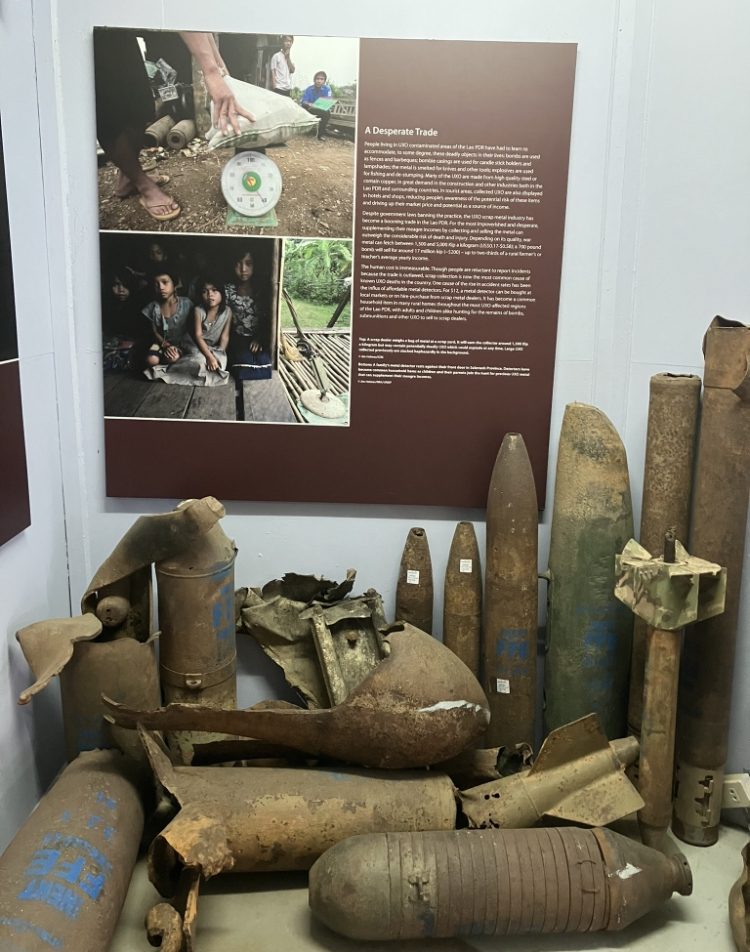
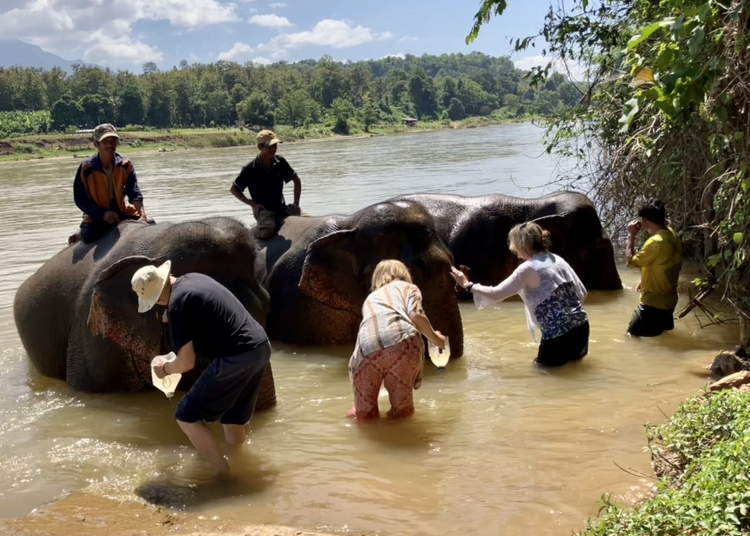
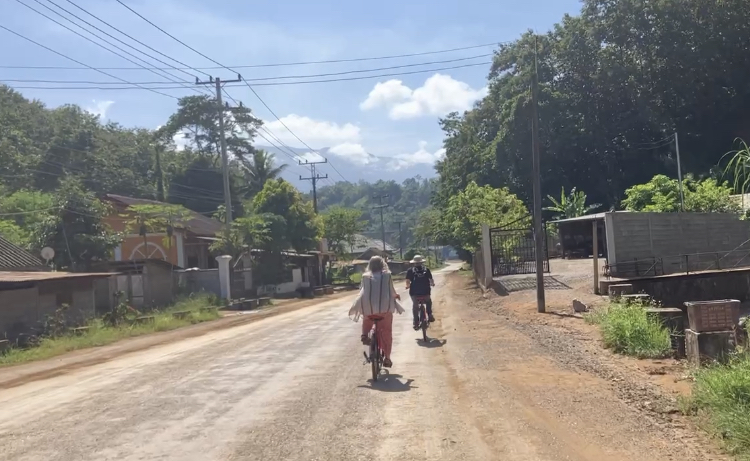
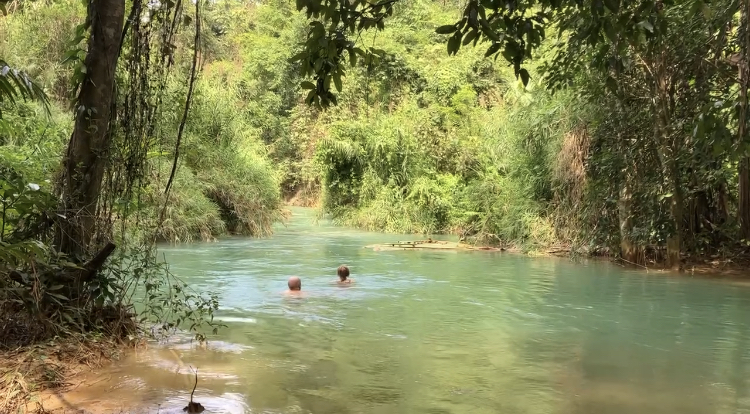
Lorem ipsum dolor sit amet, consectetur adipiscing elit. Ut elit tellus, luctus nec ullamcorper mattis, pulvinar dapibus leo.

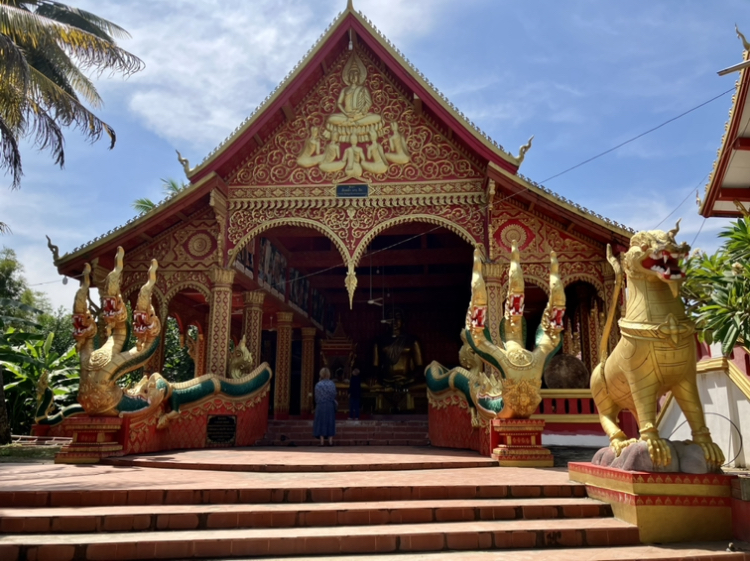
Great, insightful writing about Laos. The news you (and Shannon) reported on of US bombing there, stuns me into silence.
Hey Theo… it’s so nice to hear your voice and to get your take on the experiences you’re all having.
I totally get the inner conflict around things like the elephant conservation project and local markets. But also HOW amazing that you got to spend time with elephants!
I hope Thailand is wonderful and a bit if a break from the long train journeys! Xxx
It’s hard to comprehend the misery and damage still being done by bombs dropped since 1964, nearly 60 years! And America apparently doing nothing to help clear up the mess caused by their ‘Secret’ War. Truly shocking.
Safe Journey guys.